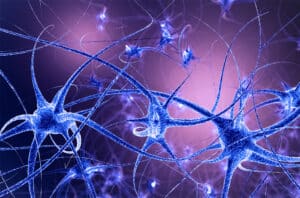The human brain has the incredible ability to perceive and process the world around us — everything from the sound of a crackling campfire to the blink of a changing traffic light. This is largely due to a phenomenon known as “synaptic plasticity,” or neural plasticity, which allows the brain to continuously change the structure and effectiveness of its neuronal connections, or synapses, in response to external stimuli.
Today’s neuroscientists still have a relatively limited understanding of neural plasticity, especially as it pertains to learning and memory. However, a recent study published in Cell Reports titled “Focal clusters of peri-synaptic matrix contribute to activity-dependent plasticity and memory in mice” describes a new mechanism of brain plasticity, defined by the presence of extracellular matrix molecules called chondroitin sulfates.
Chondroitin Sulfates and Neural Plasticity
Chondroitin sulfates are a type of complex carbohydrate molecule that is a major component of cartilage. They are often associated with joints and are sometimes used as an oral supplement to help with joint pain and inflammation. However, chondroitin sulfates also exist within the brain’s extracellular matrix and are known to play a crucial role in neural plasticity — specifically, the brain’s ability to acquire and store information.
Circular clusters of chondroitin sulfates within the brain are known as CS-6 clusters, a nod to “chondroitin sulfate-6,” which identifies the clusters’ molecular composition. Little was known about the function of these clusters until 2017, although neuroscientists did note a severe lack of clusters within the brains of individuals with psychotic disorders, including schizophrenia. To uncover the function of CS-6 clusters, researchers had to take a closer look.
Exploring CS-6 Clusters
The team behind the recent study published in Cell Reports had one specific goal when investigating the function of CS-6 clusters: to explore the structures in detail and understand their role in neural plasticity. The team began by visualizing the structures at a high resolution and found that the clusters were “essentially clusters of synapses coated with CS-6 and organized in a clearly recognizable geometric shape,” per the research team.
The team then analyzed the clusters using a combination of behavioral, molecular, and refined morphological approaches. At that point, they realized something potentially groundbreaking: that the connections encapsulated in CS-6 clusters change in response to electrical activity in the brain. In other words, the clusters play an important role in neural plasticity.
Neural Plasticity and Environmental Stimuli
The final step in the team’s research protocol involved evaluating the expression of CS-6 in the hippocampus, which is the region of the brain responsible for spatial learning and memory. To evaluate the role of CS-6, the researchers intentionally weakened the expression of CS-6 in the hippocampus by downregulating its carrier gene. At that point, the team was able to demonstrate that the presence of CS-6 is necessary for synaptic plasticity and spatial memory, strengthening the understanding that chondroitin sulfates play a key role in processing environmental stimuli.
“This work paves the way for a new way of thinking about brain functioning,” the researchers note in the abstract. “It is possible that all synapses formed on different neurons within CS-6 clusters have the ability to respond chorally to specific environmental stimuli, and are involved in a common function aimed at learning and memory processes.”
Moving forward, the team will continue evaluating information integration at the multicellular level, potentially unlocking a deeper understanding of how our brains allow us to perceive the world around us. The ongoing research could have far-reaching implications, from the treatment of psychiatric disorders to an understanding of more intricate neural processing functions.
_____
Scantox is a leading European preclinical GLP-accredited contract research organization (CRO). Since 1977 Scantox has been a trusted partner for in-vivo preclinical research services for the pharmaceutical and medical device industries. Our services and expertise enable clients to progress their drug or device development based on consistent, high-quality solid data to the highest technical and scientific standards. The Scantox services support a broad spectrum of preclinical drug development elements. From lead optimization within in vitro and in vivo efficacy models, CNS/neurology, formulation development, regulatory toxicology studies incl. supportive functions as clinical pathology, bioanalysis, histology all the way to manufacturing and distribution of products for clinical trial phase 1 and 2. For more information about our company: https://scantox.com/about-scantox/









